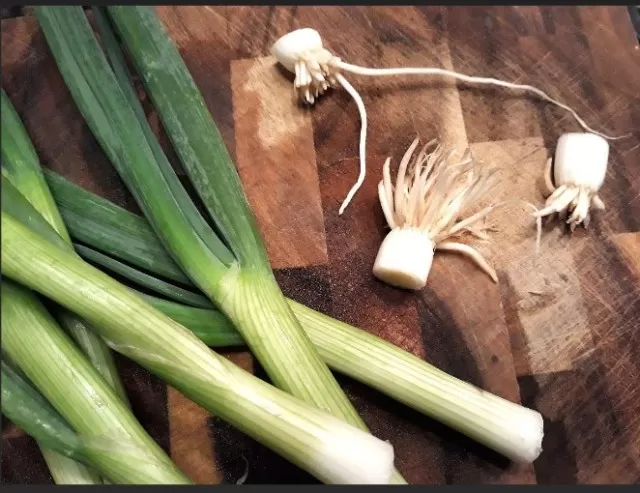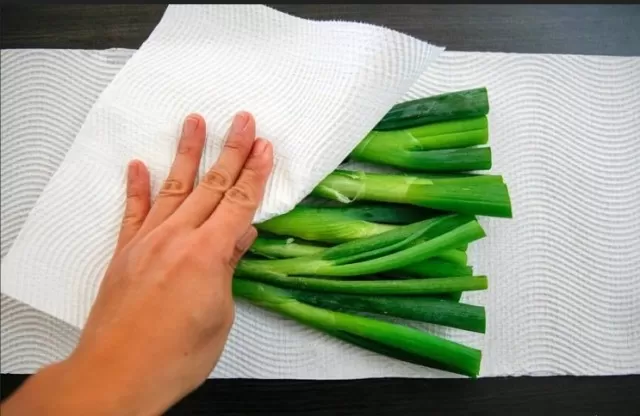Storing and Regrowing Green Onions at Home. Green onions, also known as scallions, are a versatile and flavorful addition to many dishes. To get the most out of your green onions and enjoy a continuous supply, follow these simple steps to store and regrow them. With this easy step-by-step guide, you can make the most of your green onions by storing and regrowing them, ensuring a steady source of this flavorful ingredient for your culinary creations. Enjoy the convenience of having fresh green onions at your fingertips while reducing food waste.
How to Select Fresh and Sustainable Green Onions

When it comes to picking out the perfect scallions during your grocery shopping, there are two crucial aspects to keep in mind: the bulb and the middle section of the stalk, where it branches out into vibrant green stems.
According to NaDean Johnson, a chef instructor at the Auguste Escoffier School of Culinary Arts, paying attention to these two parts is key.
First, let’s talk about the bulb.
A pristine scallion bulb should exhibit a few essential qualities. It should be clean, displaying a Bright White color with the root system still intact.
This is not just for aesthetic purposes; it also ensures the scallion’s longevity. A green onion without its roots may not stay fresh as long, and, critically, it won’t be suitable for replanting if you’re so inclined.
Johnson also advises assessing the firmness of the bulb just above the roots; it should feel solid and robust to the touch.
Moving on to the middle of the stalk, this part should also meet specific criteria.
It should be clean and dry, devoid of any signs of wilting. To gauge its freshness, you can gently give it a slight squeeze; it should have a texture akin to a plastic straw, indicating its crispness and vitality.
Should you find that the tips or outermost green stems have succumbed to wilting, don’t fret.
A simple solution is to trim them away, leaving you with the freshest and most flavorful part of the green onion to enhance your culinary creations. By adhering to these guidelines, not only will you ensure the quality of your scallions but also contribute to a more sustainable kitchen by choosing produce that can thrive if given the chance to grow again.
Optimizing the Freshness and Longevity of Green Onions: Storage Techniques
Green onions, also known as scallions, are a versatile ingredient that can elevate many dishes.
Here’s how you can store them effectively to maintain their freshness and quality:.
Refrigerated Storage:.
Take a drinking glass that’s heavy at the bottom and fill it with enough water to submerge the roots of the scallions.
Ensure that the glass is tall enough to support the length of the stalks.
Place the scallions into the glass, ensuring their roots are immersed in the water.
You can store the glass either in the refrigerator or on the countertop.
If storing in the refrigerator, loosely cover the scallions with a plastic bag and secure it in place using a Rubber Band.
Make sure to change the water every two to three days to maintain freshness.
Following these steps, your scallions can stay fresh for two to three weeks.
Freezer Storage:.
Begin by washing and drying the scallions thoroughly with paper towels or a cloth tea towel.
Removing any excess moisture is crucial to prevent sogginess upon thawing.
Slice the scallion stalks into thirds, ensuring not to cut off the root end as it helps preserve their freshness.
Lay out the cut scallions on a sheet pan in a single layer, then place the pan in the freezer.
Once the scallions have frozen solid, transfer them into a freezer-safe bag.
Expel all the air from the bag, seal it tightly, and then label it with the current date.
Stored in this manner, scallions can last for about six months in the freezer.
A note of caution: While freezing scallions is a viable option, keep in mind that they may lose some of their integrity and become somewhat soggy after thawing.
Therefore, it’s recommended to use frozen scallions in recipes where their crisp texture isn’t critical, such as in soups and sauces, rather than salads or garnishes.
Reviving Green Onions: A Simple Guide to Regrowing and Extending their Lifespan

Regrowing green onions not only saves you money but also allows you to maximize the use of this versatile ingredient without needing advanced gardening skills.
Here’s how you can effortlessly regrow green onions right in your kitchen:.
Using Water:.
When cutting green onions for recipes, ensure you reserve at least one inch of the white ends with the hair roots still attached, as advised by Anne-Marie Bonneau, author of The Zero-Waste Chef.
Place the root ends of the scallions in a narrow jar or glass, adding water so that the cut tops are exposed.
Position the jar in a sunny spot, like your countertop.
Within a few days, new green shoots should emerge.
Change the water weekly as the green stalks continue to grow.
Once the green stalks have grown a few inches, you can remove the scallions from the jar and use them in your cooking as usual.
If you wish to regrow them again, snip the greens off with kitchen scissors, leaving the white ends intact, and continue to replace the water every few days.
Please note that regrowing scallions in water is best done once or twice since water doesn’t provide the scallions with nutrients, leading to a loss of flavor and vigor with each subsequent regrowth.
Additionally, repeatedly regrown scallions may develop a slimy liquid at the base, which is normal but indicates that it’s time to start with fresh scallion bulbs.
Using Soil:.
To extend the life of your green onions even further, consider planting them in soil.
You can do this in a pot (indoors on a sunny windowsill or outdoors) or in a Garden Bed. As they continue to grow, you can repeatedly snip off the tops whenever you need green onions.
For gardening enthusiasts, you can allow the scallions to flower and go to seed, enabling you to grow fresh new onions in the future.
To accomplish this, let the flowers dry on the plant, cut off the flowers, remove the black seeds, and store them in a paper envelope, as suggested by Bonneau. Be patient, though, as scallions can take several months to flower.
It’s worth noting that the flavor of scallions changes when they flower.
If you don’t require seeds or want to maintain the mild flavor, avoid letting them reach the flowering stage and continue cutting scallions at or near the base.
With these simple techniques, you can make the most of your green onions, reduce food waste, and enjoy a fresh supply of this flavorful ingredient whenever you need it.
Harnessing the Versatility of Scallions in Your Culinary Adventures

Whether you’ve picked up fresh green onions from the store, a local farmers’ market, or regrown them in your kitchen, these versatile alliums can elevate a wide range of dishes due to their mild, onion-like flavor.
Here are some Creative Ways to make the most of scallions in your cooking:.
As a Raw Garnish: The sharp and peppery flavor of raw scallions makes them an excellent choice for garnishing a variety of dishes. Sprinkle chopped green onions over dips, soups, stews, pasta salads, mashed potatoes, or meat dishes to add a burst of freshness and a subtle zing.
In Stir-Fries: Cooking scallions in stir-fries is a fantastic way to incorporate their flavor while mellowing out their spiciness. Add chopped scallions towards the end of the stir-fry cooking process to preserve their vibrant green color and crisp texture.
In Baking: Get creative in the kitchen by incorporating scallions into baked goods like quick breads or savory muffins. Chopped scallions can add a delightful depth of flavor to these treats.
As Stuffing: Enhance the flavor profile of your meats by incorporating scallions into stuffing mixtures. Whether you’re stuffing poultry, pork, or even tofu, scallions can provide a refreshing twist.
In Soups and Sauces: Use scallions as part of a mirepoix, the classic combination of onions, celery, and carrots that forms the base for many soups and sauces. Chopped scallions can add a unique dimension to your culinary creations.
Remember that scallions bring a milder flavor compared to other onion varieties, making them a versatile choice in various recipes.
Whether raw or cooked, their crisp texture and gentle oniony taste can enhance your dishes in delightful ways. So, next time you have scallions on hand, don’t hesitate to experiment and explore their culinary potential.
*The information is for reference only.